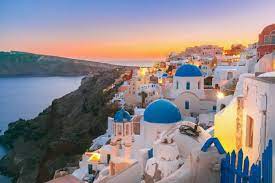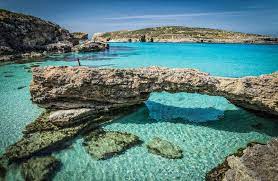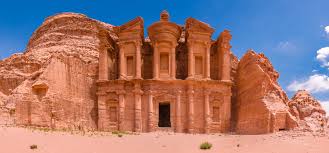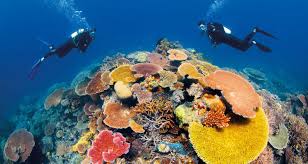Top 3 beautiful places in the world

Blue Lagon:
The Blue Lagoon is a famous geothermal spa situated in Iceland. It is located on the Reykjanes Peninsula, near the town of Grindavik and about a 40-minute drive from Reykjavik, the capital of Iceland. The Blue Lagoon is one of Iceland's most popular attractions and is visited by millions of tourists each year.

-
Geothermal Water: The Blue Lagoon's water is geothermal, originating from a nearby geothermal power plant. It is rich in minerals like silica and sulfur, which are believed to have various health benefits for the skin.
-
Temperature: The water in the Blue Lagoon maintains a comfortable temperature, usually between 37 to 40 degrees Celsius (98 to 104 degrees Fahrenheit), making it enjoyable to soak in year-round, even during Iceland's colder months.
-
Unique Blue Color: The water's vibrant blue color is a result of its high silica content, which reflects sunlight in a unique way, giving it that striking appearance.
-
Spa Facilities: The Blue Lagoon offers a range of spa facilities, including silica mud masks that visitors can apply to their skin while soaking in the water. There are also saunas, steam rooms, and relaxation areas available for guests to enjoy.
-
Surrounding Landscape: The surrounding volcanic landscape adds to the otherworldly charm of the Blue Lagoon. The steam rising from the warm waters against the backdrop of rugged lava fields creates a surreal and picturesque setting.
-
Responsible Tourism: The Blue Lagoon is dedicated to environmental sustainability and strives to protect the natural surroundings while providing an unforgettable experience for visitors.
If you plan to visit the Blue Lagoon, it is essential to book your visit in advance, as it can get quite busy, especially during peak tourist seasons. The experience of bathing in the soothing, mineral-rich waters amidst the stunning Icelandic landscape is one that many travelers find to be both relaxing and rejuvenating.
Petra:
Petra is an ancient historical and archaeological city located in present-day Jordan. It is one of the most iconic and famous archaeological sites in the world and is often referred to as the "Rose City" due to the color of the stone from which it is carved.

-
Historical Significance: Petra was the capital city of the Nabateans, an ancient Arab civilization that thrived in the region from around the 4th century BCE to the 1st century CE. The Nabateans were skilled at carving structures directly into the rock, creating a remarkable city that was both a trading hub and a major cultural center.
-
Architecture: The most well-known structure in Petra is the Treasury (Al-Khazneh), which is a grand, ornate building carved into the sandstone cliff. It is believed to have been a tomb or mausoleum. There are also numerous other tombs, temples, a theater, and other structures carved into the cliffs and hillsides throughout the ancient city.
-
Access: To reach the main site of Petra, visitors have to pass through a narrow and winding gorge called the Siq, which is a natural geological formation. The Siq is a stunning walkway with towering cliffs on either side, leading to the reveal of the Treasury at the end, making the entrance to Petra an awe-inspiring experience.
-
UNESCO World Heritage Site: Petra was designated as a UNESCO World Heritage Site in 1985 and is also considered one of the New Seven Wonders of the World.
-
Movie Fame: Petra's stunning architecture and unique landscape have made it a popular location for movies and documentaries, including "Indiana Jones and the Last Crusade," where it served as the fictional "Canyon of the Crescent Moon."
-
Tourism: Petra attracts tourists from around the globe who come to explore this ancient wonder. The site offers guided tours, horse rides, and a chance to witness the city's breathtaking beauty and historical significance.
Visiting Petra is a unique opportunity to step back in time and experience the marvels of an ancient civilization. However, due to its popularity, conservation efforts are essential to preserve the site for future generations. If you plan to visit, remember to be respectful of the historical treasures and the local culture.
Great Barrier Reef:
The Great Barrier Reef is the world's largest coral reef system, located off the northeast coast of Australia. It is one of the most renowned natural wonders of the world and holds significant ecological, biological, and environmental importance. Here are some key facts about the Great Barrier Reef:

-
Size and Location: The Great Barrier Reef stretches over 2,300 kilometers (approximately 1,429 miles) along the Queensland coast of Australia. It covers an area of about 344,400 square kilometers (approximately 133,000 square miles). The reef is made up of thousands of individual coral reefs and islands, creating a vast and diverse marine ecosystem.
-
Biodiversity: The Great Barrier Reef is incredibly rich in biodiversity, home to thousands of plant and animal species. It is home to numerous species of corals, fish, mollusks, sharks, rays, dolphins, sea turtles, and more. The reef also supports a variety of bird species on the surrounding islands.
-
Coral Reefs: The Great Barrier Reef is primarily composed of hard corals, which are colonies of tiny animals called polyps that secrete calcium carbonate to build a hard, protective skeleton. These coral reefs create complex habitats for countless marine species, serving as nurseries, feeding grounds, and shelter.
-
Threats: The Great Barrier Reef faces several threats, including coral bleaching due to rising ocean temperatures caused by climate change, ocean acidification, pollution from human activities, overfishing, and coastal development. These factors contribute to the deterioration of coral health and biodiversity.
-
UNESCO World Heritage Site: The Great Barrier Reef was inscribed as a UNESCO World Heritage Site in 1981 in recognition of its outstanding universal value and significance. It is a protected area, and various conservation efforts are in place to preserve its ecological integrity.
-
Tourism: The Great Barrier Reef is a major tourist attraction, drawing visitors from around the world who come to explore its vibrant underwater world through snorkeling, scuba diving, boat tours, and underwater excursions. Sustainable tourism practices are encouraged to minimize the impact on the delicate ecosystem.
Conservation and ongoing efforts to mitigate climate change and other human-induced threats are crucial to safeguarding the Great Barrier Reef and its extraordinary biodiversity for future generations. The reef's health is not only essential for the marine life it supports but also for the well-being of the global environment, as healthy coral reefs play a vital role in carbon sequestration and maintaining ocean ecosystems.








